Haringey
Explore hidden histories, historic photos, and things you never knew about Haringey from the collections and archives of Historic England.
Discover your local listed buildings and places
Introducing some of Haringey's most historic sites, included in the National Heritage List for England. Some of these captions have been summarised by AI. Click through for the official List entry. Skip this section and go to place by numbers
Tower of Old Parish Church of St Mary
Haringey
HIGH STREET N8 (South side) TOWER OF OLD PARISH CHURCH OF ST MARY.
Alexandra Palace including former Alexandra Palace Statio…
Haringey
Former International Exhibition Hall and 'People's Palace'. Rebuilt 1873-5 by John Johnson and Alfred Meeson following fire damage to the first building of 1868-73 by the same architects.
15 and 16 Bruce Grove (Elm Place) with 15A Bruce Grove
Haringey
A pair of houses dating from between 1789 and 1798, with later alterations and additions.
Cromwell House
Haringey
Cromwell House, built in 1637-38 for Captain Richard Sprignall, features Renaissance brickwork, a mansard roof with dormers, impressive interior staircases, and historical architectural...
The Beehive Public House
Haringey
Public house. 1927 replacing a Victorian public house on the site. Architect and brewery unknown.
Alexandra Palace
Haringey
Alexandra Palace, opened in 1873, was rebuilt after fires in 1875 and 1980. It serves as a venue for exhibitions and recreational activities in a historic park setting.
Christ Church
Haringey
1861-2 by A W Blomfield. 1867 S aisle. 1873 steeple. 1881 W narthex. 1906 N aisle enlarged by W A Pite.
Mosaic mural at Tangmere House
Haringey
Mosaic mural by Gülsün Erbil, 1986-1987, titled Equality-Harmony.
5 and 6 Bruce Grove
Haringey
Pair of houses dating from between 1789 and 1798, with later alterations and additions.
Wood Green Underground Station
Haringey
Underground railway station, 1932 by Charles Holden. Minor later alterations.
Finsbury Park
Haringey
Finsbury Park, London's second municipal park, was designed by Frederick Manable and Alexander Mackenzie, opened in 1869, and features diverse recreational amenities and historical elements.
Administration Block at St Luke's Hospital
Haringey
Administration block of psychiatric hospital, built 1928-30; designed by TA Pole FRIBA; built of red brick with stone dressings; hipped tile roof.
Shepherd's Cottage and rear boundary wall, 36a Highgate H…
Haringey
Cottage. Probably early-C18 in origin. Renovated and re-roofed with re-used tiles in the 1980s and the east gable was rebuilt in 2017.
Haringey Civic Centre
Haringey
Civic Centre of 1955-1958 by Sir John Brown, A E Henson and Partners, partner in charge, J E S Sayers.
Bounds Green Underground Station (Including No. 38)
Haringey
Underground railway station and shops. Opened September 1932. Designed by Charles Holloway James of Messrs CH James and Bywaters, overseen by Charles Holden for the Underground Group.
Furnival House
Haringey
Hostel for domestic staff of the Prudential Assurance Company, latterly student accommodation. 1916-1919 by Joseph Henry Pitt (b. 1871), with later-C20 modifications internally.
13 and 14 Bruce Grove
Haringey
Pair of houses dating from between 1789 and 1798, with later alterations. Converted to flats in the early-C21.
Parish Church of All Hallows
Haringey
The W tower and western six bays of the nave arcades are C14, and formerly comprised the entire church including a chancel structurally undivided from the nave. The S aisle is C15.
49, Lanchester Road
Haringey
Detached house. Built 1925-6 to the design of Ewan Macpherson of Maple & Co, for Thomas Adie. Builder Messrs Tibbenham of Ipswich.
11 and 12 Bruce Grove
Haringey
Pair of houses dating from between 1789 and 1798, with later alterations and converted to flats in the 1980s.
Church of St James
Haringey
1900-02 and steeple 1909-10 by J.S Alder. Attached church hall by Caroe and Partners, 1994-95.
9 and 10 Bruce Grove including the front boundary wall to…
Haringey
Pair of houses dating from between 1789 and 1798, with later alterations and additions. The rear extension and link block to number 9 does not form part of the listing.
Explore more
Search for more listed placesHaringey through time
This timeline shows the first period of use for buildings and places on the National Heritage List for England, just one of the details recorded for every list entry. Click around to see how Haringey changes over time. Skip this section and go to aerial photos
Medieval AD 1066 to AD 1540
This period, sometimes known as the Middle Ages, began with the Norman invasion in AD 1066. It saw a significant rise in military and defensive buildings such as castles and earthworks, as well as religious houses dominating a largely agricultural landscape.
The monarchy and Church dominated the period, which also saw the break with the Roman Catholic Church and the English reformation.
Post medieval AD 1540 to AD 1901
The Post-Medieval period brought seismic changes to life in England, with religious reformation leading to the democratization of worship and the destruction of hundreds of religious houses.
In parallel, there was a huge expansion of scientific study and enlightenment that permanently altered the nation's social structure and landscape. Industrialization and mass production lead to wider global trade, emigration, and immigration.
20th century AD 1901 to AD 2000
The 20th century saw an incredible expansion of England's transport networks, with suburban growth shadowing rapid infrastructural expansion. The establishment of state schools, hospitals, and modern technical colleges, with new architectural styles, radically changed the appearance of towns and cities.
Two catastrophic world wars and the 1918 pandemic also brought unprecedented change, altering England's built environment and social structures forever.
Medieval AD 1066 to AD 1540
This period, sometimes known as the Middle Ages, began with the Norman invasion in AD 1066. It saw a significant rise in military and defensive buildings such as castles and earthworks, as well as religious houses dominating a largely agricultural landscape.
The monarchy and Church dominated the period, which also saw the break with the Roman Catholic Church and the English reformation.
Post medieval AD 1540 to AD 1901
The Post-Medieval period brought seismic changes to life in England, with religious reformation leading to the democratization of worship and the destruction of hundreds of religious houses.
In parallel, there was a huge expansion of scientific study and enlightenment that permanently altered the nation's social structure and landscape. Industrialization and mass production lead to wider global trade, emigration, and immigration.
20th century AD 1901 to AD 2000
The 20th century saw an incredible expansion of England's transport networks, with suburban growth shadowing rapid infrastructural expansion. The establishment of state schools, hospitals, and modern technical colleges, with new architectural styles, radically changed the appearance of towns and cities.
Two catastrophic world wars and the 1918 pandemic also brought unprecedented change, altering England's built environment and social structures forever.
Aerial photos of Haringey
Aerial photography helps reveal secrets of England's changing landscapes that are impossible to see from the ground. Skip this section and go to archive images

Muswell Hill
Alexandra Palace, Muswell Hill, 1921
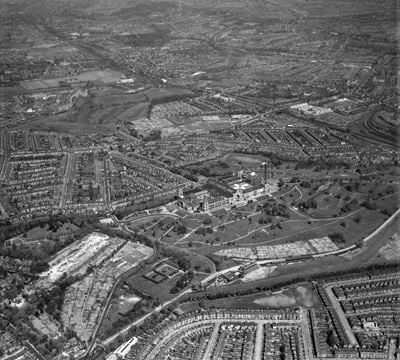
Muswell Hill
Alexandra Palace and environs, Muswell Hill, 1949
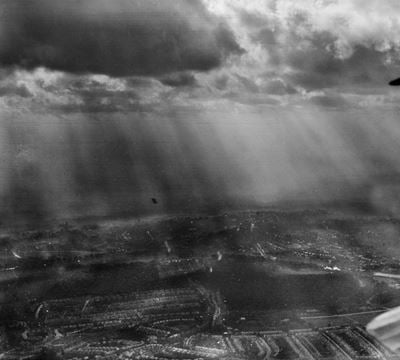
Highgate
The area of Highgate Wood, Highgate, 1923
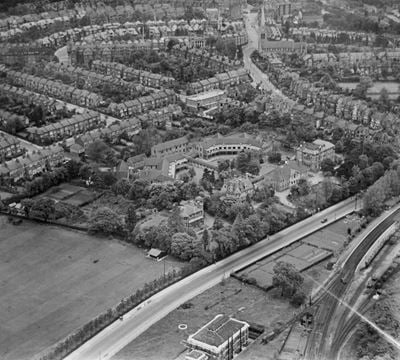
Muswell Hill
Woodside Hospital and environs, Muswell Hill, 1932

Muswell Hill
St James's Church and the surrounding residential area, Muswell Hill, 1935
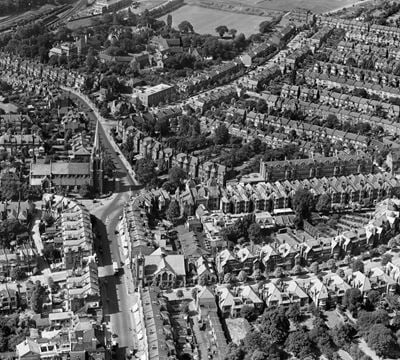
Muswell Hill
St James's Church and the surrounding residential area, Muswell Hill, 1935
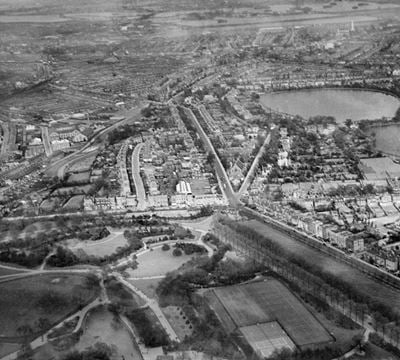
Finsbury Park
Finsbury Park and Seven Sisters Road, Finsbury Park, 1930

Finsbury Park
Finsbury Park and the East and West Reservoirs, Finsbury Park, 1930

Finsbury Park
Maynards Ltd Confectionery Works, Finsbury Park, 1921

Harringay
Maynards Ltd Confectionery Works, Harringay, 1951
Haringey in the Historic England Archive
The Historic England Archive cares for over 15 million images, dating from the 1850s to the present day. Discover stunning images of Haringey's past. Skip this section and go to stories about heritage
Charles George Harper Collection
Tottenham, Haringey, Greater London Authority
Date created: 1892 - 1933
The Tottenham High Cross
John Gay Collection: London
Highgate, Haringey, Greater London Authority
Date created: early 1960s
A night time view of brightly lit, snow covered gravestones in the graveyard of Highgate School Chapel
John Gay Collection: Highgate and Hampstead
Highgate, Haringey, Greater London Authority
Date created: 1967
A night view looking through the window of the Dukes Head public house into the crowded bar
John Gay Collection: Modern Architects
Highgate, Haringey, Greater London Authority
Date created: 1980 - 1981
Angel Yard, Highgate showing the former stable block of the Angel Inn prior to conversion to residential use
John Gay Collection: Advertising and Promotional Photographs
Haringey, Greater London Authority
Date created: 1945 - 1949
A factory worker receiving dental treatment in the dentist's surgery at Barratt's confectionery works in Wood Green shortly after the end of the...
John Gay Collection: Miscellaneous
Highgate, Haringey, Greater London Authority
Date created: 1960 - 1985
Looking along the back garden towards the rear elevation of 33 Cholmeley Park
John Laing Collection
Haringey, Greater London Authority
Date created: 05 Oct 1978
A view showing part of Wood Green Shopping City including a raised concrete ramp during construction work
London, Midland and Scottish Railway Company
Highgate, Haringey, Greater London Authority
Date created: 1923
A view of the carved wooden staircase in Cromwell House, taken from the landing between the ground and first floors
Nigel Temple Collection of Postcards of Parks and Gardens
Hornsey Gardens, Haringey, Greater London Authority
Date created: 1905 - 1910
GENERAL VIEW
John Gay Collection: Highgate and Hampstead
Highgate, Haringey, Greater London Authority
Date created: 1967
A night view looking through the window of the Dukes Head public house into the crowded bar
John Gay Collection: Modern Architects
Highgate, Haringey, Greater London Authority
Date created: 1980 - 1981
Angel Yard, Highgate showing the former stable block of the Angel Inn prior to conversion to residential use
John Gay Collection: Miscellaneous
Highgate, Haringey, Greater London Authority
Date created: 1960 - 1985
The front elevation of 33 Cholmeley Park
Stories about heritage in your local area
Historic England publishes news, blogs, research, videos, and podcasts celebrating England's rich heritage. Discover the stories we have about Haringey. Skip this section and go to education
The Buildings of Architect Ernő Goldfinger
Mentions Highpoint I Highpoint I (Numbers A to D) Highpoint I (Numbers G,h,I,k)
Discover the modernist buildings of Hungarian-born architect Ernő Goldfinger, including Trellick Tower, Balfron Tower and 2 Willow Road.
The Modernist Buildings of Engineer Ove Arup
Mentions Highpoint I Highpoint I (Numbers A to D) Highpoint I (Numbers G,h,I,k), Highpoint II
Ove Arup is considered to be one of the most important structural engineers of the 20th-century. Here’s our guide to his most significant work.
A Brief Introduction to Shopping Parades
Mentions 107-123, Muswell Hill Road, N10
Shopping parades are a familiar sight in urban areas across England.
7 International Architects who Helped Shape England
Mentions Highpoint I Highpoint I (Numbers A to D) Highpoint I (Numbers G,h,I,k), Highpoint II
Architects from around the world have contributed to England’s built environment.
Recording 19th Century Lantern Slides
We've acquired the earliest surviving aerial images of England. Taken from an air balloon by photographer and balloonist Cecil Shadbolt from 1882-1892, this essential collection of 76 Victorian glass lantern slides has now been conserved, digitised, catalogued and researched. The collection was miraculously found at a car boot sale and was bought by the Archive at auction in 2015.
Restoring 19th Century Lantern Slides
We've recently acquired the earliest surviving aerial images of England. Taken from an air balloon by photographer and balloonist Cecil Shadbolt from 1882-1892, this essential collection of 76 Victorian glass lantern slides has now been conserved, digitised, catalogued and researched. The collection was miraculously found at a car boot sale and was bought by the Archive at auction in 2015.
England's Suburbs 1820-2020
Mentions Haringey
Historic England’s major national research project on the heritage of suburbs reaches its conclusion.
Grant Awarded to Alexandra Palace to Help Restore Unique Spaces
Mentions Alexandra Palace, Haringey
Historic England has awarded a £550,312 grant to Alexandra Palace to help bring a derelict section of the East Wing back into use.
New Interactive Centenary Map of UK Buildings and Places That Have Defined the BBC
Mentions Alexandra Palace
Launched by Historic England, Historic Environment Scotland, Historic Environment Division, Northern Ireland Communities Department and Cadw.
British Library Listed at Grade I
Mentions Haringey
The British Library and seven local libraries across England are being listed as the best examples of public libraries of the later 20th century.
Haringey's social history through photos
Over 10,000 images from the Historic England Archive have been specially selected and re-captioned for teachers, students, and anyone who wants to learn more about their local area. Skip this section and go to grant-aided places
Tottenham Palace Theatre, High Road, Tottenham, Greater London
Period: Edwardian (1902 - 1913)
The Tottenham Palace Theatre was built in 1908 by Oswald Cane Wylson of Wylson and Long. It was built as a variety theatre.
Tottenham Palace Theatre, High Road, Tottenham, Greater London
Tags
Tottenham Lane, Hornsey, Greater London
Period: World War One (1914 - 1919)
Tottenham Lane looking north-east towards a row of cottages and Holy Innocents' Church. Photographer: Spiers
Tottenham Lane, Hornsey, Greater London
Tottenham High Road, Haringey, Greater London
Period: Victorian (1837 - 1901)
A horse-drawn omnibus has paused to pick up passengers outside a row of shops, including a junk shop.
Tottenham High Road, Haringey, Greater London
The Queen's Public House, Hornsey, Greater London
Period: Victorian (1837 - 1901)
The former Queens Hotel was built in 1899-1901 and is one of London's grandest pubs from this date. It was developed by John Cathles Hill.
The Queen's Public House, Hornsey, Greater London
St Marys Church, High Street, Hornsey, Greater London
Period: 1970s (1970 - 1979)
The nave of St Mary's Church, during demolition. Photographer: N Beacham, National Monuments Record (RCHME)
St Marys Church, High Street, Hornsey, Greater London
Shoeing forge, North Road, Highgate, London
Period: Edwardian (1902 - 1913)
Two farriers stand in the doorway of T Hayhoe's shoeing forge (established 1760) on the North Road in Highgate, London.
Shoeing forge, North Road, Highgate, London
Old Crouch Hall School, The Broadway, Crouch End, Greater London
Period: Victorian (1837 - 1901)
Crouch End grew up as a hamlet on the old medieval route from London to the north. It was a heavily wooded area containing farms and country houses.
Old Crouch Hall School, The Broadway, Crouch End, Greater London
North Road, Highgate, London
Period: Edwardian (1902 - 1913)
A typical view of workers' houses from the early 20th century in north London.


